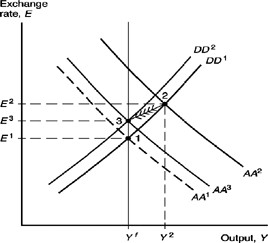第八章单元测试
- Which one of the following statements is MOST accurate? ( )
- What have we assumed when we conclude that a real depreciation of the currency improves the current account? ( )
- The DD schedule shows all combinations of which 2 variables so that the output market is in equilibrium? ( )
- Which of the following does NOT affect the position of the DD curve? c( )
- In the short-run, a temporary increase in the money supply_____. ( )
- Which one of the following statements is the MOST accurate? ( )
- Imagine that the economy is at a point that is above both AA and DD, where both the output and asset markets are out of equilibrium. Which first action is 对? ( )
- Which of the following have to be in equilibrium for the economy to be in equilibrium? ( )
- A permanent fiscal expansion______. ( )
- The percent by which import prices rise when the home currency depreciates by 1% is the degree of ______. ( )
- One implication of an empirical investigation of the Marshall-Lerner condition is that, in the ________, a real ________ in a nation's currency is likely to ________ the country's current account balance. ( )
- Any disturbance that raises aggregate demand for domestic output shifts the DD schedule to the right. ( )
- The AA-curve has a negative slope because an increase in Y will cause E to fall (a domestic currency appreciation). ( )
- Demonstrate how a permanent fiscal expansion will not increase output in the long run.
economy starts in long-run equilibrium, a permanent fiscal expansion will cause______. ()
Explain the following figure:

A:In general, consumption demand rises by the same amount as disposable income rises.
B:In general, consumption demand rises by less than disposable income.
C:In general, consumption demand rises by more than disposable income.
D:In general, consumption demand rises by more than income.
答案:In general, consumption demand rises by less than disposable income.
A:All else equal and the volume effect equals the value effect.
B:The volume effect outweighs the value effect.
C:All else equal and the value effect outweighs the volume effect.
D:All else equal and the volume effect outweighs the value effect.
A:output and the exchange rate
B:foreign prices and the exchange rate
C:output and exports
D:imports and exports
A:taxes
B:price levels
C:monetary policy
D:government spending
A:shifts the AA curve to the left, decreases output and depreciates the currency.
B:shifts the AA curve to the right, increases output and appreciates the currency.
C:shifts the AA curve to the left, increases output and depreciates the currency.
D:shifts the AA curve to the right, increases output and depreciates the currency.
A:For asset markets to remain in equilibrium, a fall in domestic output must be accompanied by an appreciation of foreign currency, all else equal.
B:For asset markets to remain in equilibrium, a rise in domestic output must be accompanied by a depreciation of domestic currency, all else equal.
C:For asset markets to remain in equilibrium, a rise in domestic output must be accompanied by an appreciation of domestic currency, all else equal.
D:For asset markets to remain in equilibrium, a fall in domestic output must be accompanied by an appreciation of domestic currency, all else equal.
A:The AA-DD equilibrium will shift to the position of the economy.
B:The exchange rate will first move left to a position on the AA schedule.
C:The exchange rate will first move to a point on the DD schedule.
D:The exchange rate will first drop to a point on the AA schedule.
A:the goods market only
B:the money market only
C:the output and asset markets
D:the savings and investment markets
A:shifts the DD and the AA schedules to the right, decreasing output.
B:shifts the DD and the AA schedules to the left, leaving output the same.
C:shifts the DD to the right and the AA schedule to the left, leaving output the same.
D:shifts the DD to the left and the AA schedule to the left, decreasing output.
E:shifts the DD and the AA schedules to the right, increasing output.
A:pass-through from exchange rates to import prices.
B:roll-forward from exchange rates to import prices.
C:pass-beyond from exchange rates to import prices.
D:pass-on from exchange rates to import prices.
A:short-run; appreciation; improve
B:short-run; depreciation; improve
C:long-run; appreciation; improve
D:long-run; depreciation; improve
A:对 B:错
A:错 B:对
A:a decrease in exchange rate, E. B:a decrease in output, Y. C:an increase in output, Y. D:an increase in exchange rate, E.
温馨提示支付 ¥3.00 元后可查看付费内容,请先翻页预览!




